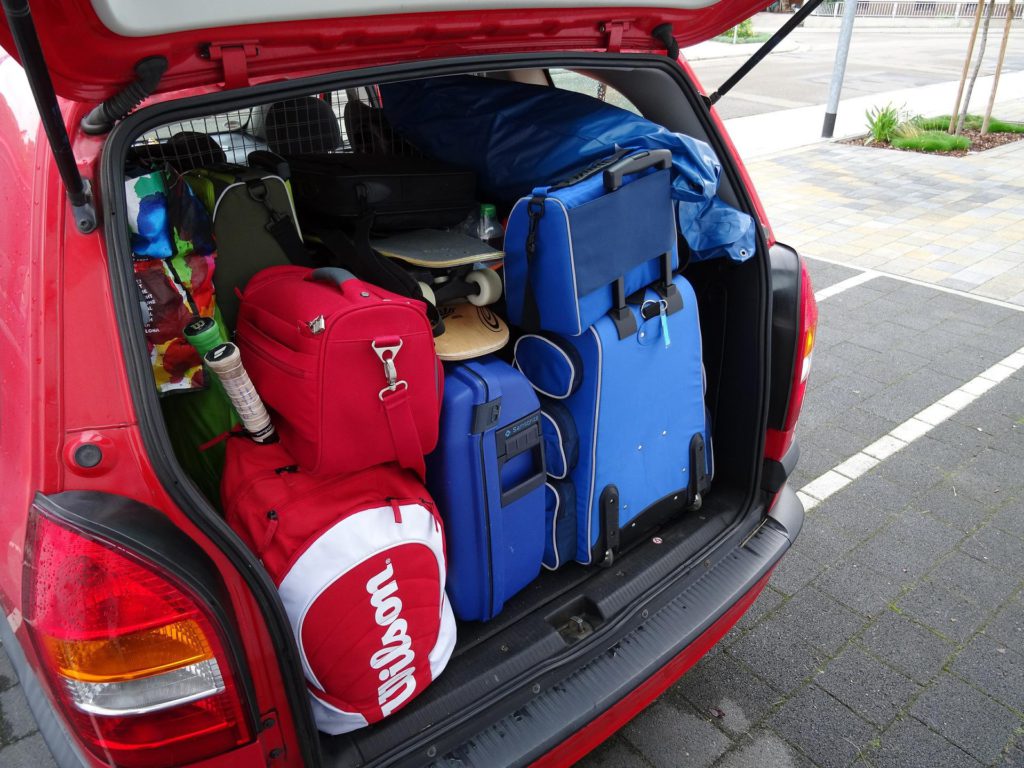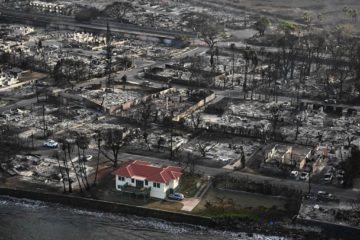Contents
This post will attempt to break down what happens prior to and during an evacuation.
The goal is to learn from the past and learn from other’s experiences, in order to better prepare for such for an evacuation contingency.
Accepting the possibility that you may need to evacuate one day is the first step to prepare for it.
This article will focus on evacuations from a home and will cover the following topics:
- Psychology before and during an evacuation
- Evacuation types
- Framework of evacuating
What Does It Mean To “Evacuate”?
The term “evacuation” or “bugging out” means leaving your home, work, or other current location for safety in another location.
A Last Resort
It is critical to note that evacuating your home should be the last resort.
Leaving a shelter, especially your home, means leaving a place where you are safe, have familiarity, security, and protection from the elements.
When in transit, you are more exposed to unsanitary conditions, criminals, and the potential chaos of the disaster itself.
If a major disaster is imminent, or if you do not have a choice (such as an impending tsunami) leave sooner rather than later.
Psychology at Play

When it comes to evacuating, similarly to investing, past results do not guarantee future outcomes. If you have previously evacuated your home, for example, and returned to a looted shell, you may feel compelled to stay the next time you’re advised to leave.
It may be very difficult, but you must evaluate every situation as if it were completely different from the past.
Your biases may also play a role when it comes to evacuations or overall analysis of the current situation. If you have strongly disagreed with the politics of the mayor or governor in the past, you are more likely to ignore their advice to evacuate.
Balancing the information you receive with your own judgements may get very difficult when under stress. Establishing a threshold (discussed further in this article), may help in making clearer decisions.
Mandatory Evacuations
If there is an imminent threat, like from a fire or any other hazard where human life is at great immediate risk, the authorities may issue a mandatory order to leave the premises. This order may come in the middle of the night, or any other time when you least expect it.
Being prepared for such a contingency can help when the stress is high and the clock is ticking.
In a way, being ordered to evacuate may be easier than determining whether you should on your own because the difficult decision has already been made for you.
Prior to hurricane Irene making landfall on the Eastern seaboard of the United States in 2011, states of emergencies were declared in 14 states and the District of Columbia, which activated emergency plans. Hundreds of thousands of people who were deemed to be in harm’s way evacuated their homes under this mandate.
Legally, penalties and consequences of disobeying a lawful order come into play for defying an evacuation mandate. In states like Maryland and California, these have been codified as criminal offenses. A person who fails to evacuate is committing a crime and subject to arrest—meaning the police can seize the person and take them elsewhere, that is, evacuate them.
Voluntary Evacuations
There may come a time when you need to make an independent decision whether you will pack up your family and leave your home. This is by no means an easy choice. By the time you seriously consider leaving your home, the surrounding situation has probably deteriorated severely.
Porter Ranch – A Stark Lesson

In October 2015 the residents of Porter Ranch in California experienced a major methane gas leak from the SoCal Gas company. Invisible methane gas is 70 times more potent than carbon dioxide, and the amount released by the spill in one month was equivalent to 200,000 automobiles’ emission of greenhouse gases in one year.
Long after residents started getting sick, SoCal Gas did little to nothing to evacuate the residents, stop the gas leak, or provide health care services. It was only until mid-December of that year (2 months after the leak began) that local health officials started issuing mandates for the company to relocate residents of Porter Ranch at the company’s expense. The residents who could have left on their own did so early, the ones who could not were left at the mercy of SoCal Gas and the government.
The governor of California, Jerry Brown, declared a state of emergency in early January of the following year, a full 3 months after the leak started. This had legal implications for the families, meaning they had no backing or assistance from the state up to that point. The empty homes that were left behind had to be protected by an already stretched-thin LAPD. Legal, financial, healthcare, moving, and other costs associated with the gas leak initially had to be covered by individual residents.
Porter Ranch – It May Happen To You
None of the residents who were interviewed believed something like this could have happened to them. The dangers of the gas fields were not disclosed to homeowners or renters prior to the leaks. The moral of the story is that it is better to prepare ahead of time for an evacuation, regardless of the reason, long before you need to evacuate or wait for anyone else to make the decision for you. Making the decision and having the capacity to voluntarily evacuate is much easier if you have a plan for it.
Keep in mind, there could be a myriad of reasons why you would need to voluntarily evacuate, not all of which include a major disaster. Major problems with your apartment, like a backed up sewage system which will take a week to repair or a prolonged electrical outage, may turn your apartment uninhabitable.
Evacuation Framework & Breakdown
Every situation that calls for an evacuation may be unique, here are the phases that generally occur:
1. Preparation

This phase only applies to those who prepare for an evacuation event.
Preppers are primed to bug-out of their home long before the need arises.
- Formulate contingency plans and checklists
- Organize supplies in a mobile-ready fashion
- Prepare a bug-out location or locations
- Maintain a means of transportation. This may include automobiles, motorcycles, bicycles, or even a good pair of shoes and appropriate clothing.
- Practice evacuation
2. A Disaster or Significant Event Occurs

This could be anything such as an earthquake that triggers a tsunami warning, a looming forest fire, etc. Some events that will ultimately trigger an evacuation may or may not be obvious, nor are they necessarily close by.
3. Detection
How will you be notified that a significant event occurred which may warrant an evacuation? This may depend on where you are, the time of day, your proximity to the event, etc.
Local detection examples:
- Smoke alarm
- Carbon monoxide detector
- Tsunami warning area notification system
- Reverse 911
- Local authorities with bullhorns or knocking on doors
- Looking out of the window
Future, forecasted, or wider area detection examples:
- Television news outlets
- Internet / smartphone notifications
- Radio
- Portable scanners
- Weather radios
- City/county/state alerting system
When it comes to detection, each person must account for their own unique circumstance. For example, an individual who is hearing impaired may need to rely on special warning devices suited for the disabled.
Over the course of many disasters in the last few decades, it has been shown that the responsibility to be informed of your surroundings (and threats to you) lands on YOU, the individual. Government services and news outlets will do their best to notify you, but there is no guarantee.
4. Decision to Prepare to Leave
Even if there is ample warning, and plenty of time to evacuate calmly, the decision to load up your supplies and prepare the family may be more difficult than first imagined.
The person making that call must accept that the reality has changed, or may change soon. Your home is a safe place where all your supplies, family, and memories are. Evacuating your home means you will become a refugee. This may be very difficult, especially if you consider other factors such as:
- The effect on your kids – Their safety undoubted comes first, but routine will and perhaps their sense of safety will change
- Rising anxiety levels – Fear may dominate your decision-making. Almost all evacuation scenarios lack perfect information, and this may add to your uncertainties.
- Influence from peers – what your neighbors say or do may increase the perceived pressure on you to stay or leave
- Other complications such as the elderly, disabled persons, poor weather, or poor health
- Deteriorated security – If everyone in town leaves, who will watch over the town and prevent looting?
5. Prepare for Departure

Whether you have 5 minutes or 5 hours to prepare for an impending evacuation, start to do so as soon as possible, even if the chances of needing to leave appear slim. It is better to unpack later than to have major regrets.
Preparing to evacuate your home involve these basic steps:
- Ensure your family is aware of the situation and are preparing to evacuate. Unless your children are really young, it may be wise to inform them (calmly) that they may be leaving for a while.
- Load your supplies into your mode of transportation. This may mean grabbing a bug-out bag and loading up your vehicle.
- Gather as much information as possible. What are the road conditions? Which way will you be traveling? What is your destination?
- Decide when you will leave. Set a threshold so that when certain conditions are met, you will leave. For example, if the fire gets within 5 miles (ca. 8 kilometers).
- Be on alert and ready to go
The process of preparing to evacuate can be made easier by the use of checklists, as further explained in this article.
6. Decision to Go

While there is no true barometer for making this difficult and critical decision, once you decide it’s time to go, then go.
Here are some questions to help with that decision:
- Has the situation gotten progressively worse?
- Is your bug-out destination safer than your current location?
- Has your threshold you set (in the previous phase) been reached?
7. Evacuate
It is time to go. Leave your home calmly. Always remember that your top priority is the health and safety of your family, not the structure of your home, or any supplies you may have inside it.
Conclusion
Becoming a refugee when leaving your home is never going to be easy. Developing a mindset, well ahead of a disaster, that an evacuation may be necessary in the future is the first step to preparing for that possibility.
Learn from the experience of others who had to evacuate by asking questions such as:
- What did they take?
- Do they have any regrets?
- What were the biggest hurdles?
- What information or tool would have made the situation better?
Apply the lessons learned to your life, and always document in the form of checklists for easy recall during an emergency.
Just like we use a seat belt in the hopes of never needing it, use your means to learn and prepare yourself to evacuate.
The key is to understand that anyone (yes, even you reading this) may need to evacuate at some point in the future, even if you never have, or do not know anyone who has.
Action Items:
Home Preparations:
- Pack all emergency supplies in easy-to-carry transportable containers
- Clearly mark transportable containers: What are the contents & its priority
Home Readiness
- Keep abreast of your surroundings
- Have a primary and backup means to receive emergency information (via TV, internet, radio, etc)
- Learn the routes of at least two ways out of town
- Communicate with your trusted circle on your evacuation destination or rally point
Vehicle Preparations
- Designate a primary vehicle to evacuate
- A designated vehicle should always be in good working order
- Maintain a minimum fuel level, or safely store additional fuel at home
- Keep a basic toolkit in the trunk for basic automotive repairs
- Ensure there is enough trunk space for emergency supplies
Practice Evacuating
Simulating evacuating your home is a critical exercise in which you may learn the limits and weaknesses of your plan, with the goal of refining and improving it.
The more rehearsed you become at evacuating, the less time, and fewer regrets, you may have if the real thing were to take place.



0 Comments